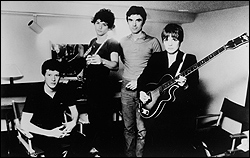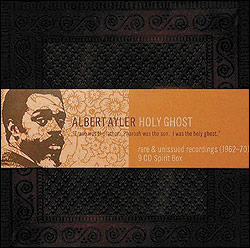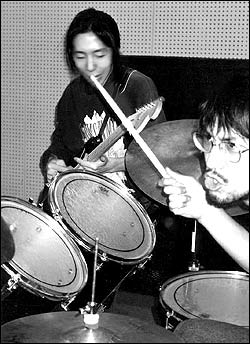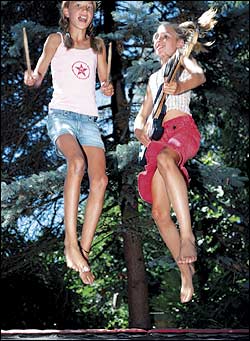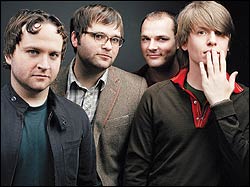Given the Band’s fondness for contemporary art, it’s only fair to divide Talking Heads’ career into early, middle, and late periods. The newly revised version of their 1982 live retrospective, The Name of This Band Is Talking Heads (Rhino), covers the first (and part of the second) like a reverential, enormous gallery show. (One of the last major albums of the vinyl era to make it to CD, it’s now twice as long as the original double LP.) The point isn’t to present a snapshot of an unlikely but electrifying live band, as they did two years later with the concert movie Stop Making Sense and its soundtrack; it’s to demonstrate how they evolved over five years into something vastly different from what they were at the beginning, by way of performances pulled from a bunch of different shows.
Disc one covers the Heads’ early period, 1977–79: their first two records, when they were a bunch of Rhode Island School of Design refugees who thought it’d be funny to be the most uptight rock band of all time. They had no violence or sex in their name, which was slang for boring visuals. While their peers at New York club CBGB, where the Heads got their start along with the Ramones, Patti Smith, and Blondie, were ripping their T-shirts and striking rebel poses, Talking Heads wore button-down shirts and dress slacks onstage. Singer/guitarist David Byrne introduces the album by declaring, in the voice of a man at a podium terrified of the committee in front of him, “Name of this song is ‘New Feeling,’ . . . and that’s what it’s about.” Most of the early songs, actually, are about trying to prove how uncool they were. “My building has every convenience/It’s going to make life easy for me/It’s gonna be easy to get things done/I will relax along with my loved ones,” Byrne enunciates in “Don’t Worry About the Government,” and he more or less means it, or at least acts like he’s convincing himself that the brochure meant it.
That’s art-school lesson No. 1: Make every work serve a conceptual purpose beyond its literal meaning—and if you’re going to make a career of it, make every work part of a continuous conceptual arc. (From the get-go, everything Talking Heads recorded supported whatever image they were building for themselves at the time, from the eccentric microanalysis of 1979’s Fear of Music to the put-on-a-normal-face Americana of 1986’s True Stories.) Very quickly, they also adopted lesson No. 2: Do whatever it takes to make your work resemble no one’s but your own.
By halfway through the first disc of The Name of This Band, it’s 1978 and Talking Heads have discovered their secret weapon: Byrne’s unobtrusively extraordinary rhythm guitar playing, which abstracts Chic guitarist Nile Rodgers’ glancing chicken-scratch into a near-constant flutter. (Tina Weymouth, meanwhile, has realized that she can afford to show off on bass: The star of “Mind” is her instrument’s swoops and squiggles.) By this point, the band have also begun their collaboration with Brian Eno, then effectively a conceptual artist whose medium was pop music, and they’re starting to test how far they can stretch the anti-cool aesthetic. They’re not quite as stiff-legged as they used to be, either: When Byrne sings “Artists Only,” he’s still not anything like a singer—but he’s not being faux-naïf any more, he’s just being weird, and he sounds liberated. The new reissue includes three songs from a heavily bootlegged 1979 promo album, including “Electricity,” an early, not-quite-gelled version of the song that became “Drugs” on Fear of Music (reprised in its better-known form on disc two); by that point, they’ve got as much swing in their stride as they’re going to get without help.
So, for the second disc, documenting 1980–81, the first couple of years of their middle period, the four core Heads call in reinforcements—an expanded ensemble including guitarist Adrian Belew and members of Labelle and Funkadelic. The albums they’re drawing on here, Fear of Music and Remain in Light, tend to get called their funk records, but they don’t much resemble any other dance music of the time, and not just because of Byrne’s mortified-nerd quaver. Taken as funk, this incarnation of Talking Heads is a little too afraid to be vulgar, a little too concerned with complicating the groove. On its own terms, though, which is to say as the next step in the band’s conceptual arc, it’s a great idea (although the studio versions mostly beat these). The entire huge group follows the direction Byrne’s and Weymouth’s guitar and bass playing have been pointing, and even though their rhythms’ metamorphosis from straight lines to sinuous curves is complete, loose dance jams like “Born Under Punches” and “Crosseyed and Painless” are recognizable as the work of the same entity that played “Don’t Worry About the Government.”
The expanded Name of This Band includes versions of every significant song from the first four Talking Heads records, a couple of them more than once. “Psycho Killer,” notably, appears on both the 1977–79 and 1980–81 halves. It mutated continuously from tour to tour: an explosively tense twitch of a song that turned into a guitar duel as guitarist/keyboardist Jerry Harrison became integrated into the band; an extended glam-rock freakout by the dawn of the Eno era; a dense, discofied stomp in the early ’80s; and eventually the pruned-back acoustic guitar-and-beatbox jitterbug of Stop Making Sense (after which the band began its late period and stopped touring). That’s another visual artists’ trick Talking Heads picked up: If you let change guide you, you can make the same piece over and over, and it’ll be different every time.
